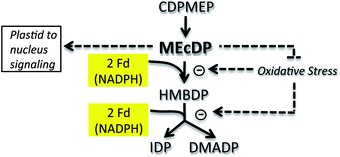Methylerythritol 4-phosphate (MEP) pathway metabolic regulation
Abstract
Covering: up to February 2014
The methylerythritol 4-phosphate (MEP) pathway is the recently discovered source of isoprenoid precursors isopentenyl diphosphate (IDP) and dimethylallyl diphosphate (DMADP) in most bacteria, some eukaryotic parasites, and the plastids of plant cells. The precursors lead to the formation of various isoprenoids having diverse roles in different biological processes. Some isoprenoids have important commercial uses. Isoprene, which is made in surprising abundance by some trees, plays a significant role in atmospheric chemistry. The genetic regulation of this pathway has been discussed but information about metabolic regulation is just now becoming available. This review covers metabolic regulation of the MEP pathway starting from the inputs of carbon, ATP, and reducing power. A number of different regulatory mechanisms involving intermediate metabolites and/or enzymes are discussed. Some recent data indicate that methylerythritol cyclodiphosphate (MEcDP), the fifth intermediate of this pathway, is a key metabolite. It has been found to play diverse roles in regulation within the pathway as well as coordinating other biological processes by acting as a stress regulator in bacteria and possibly a retrograde signal from plastids to the nucleus in plants. In this review we focus on the role of the MEP pathway in photosynthetic leaves during isoprene emission and more generally the metabolic regulation of the MEP pathway in both plants and bacteria.


 Please wait while we load your content...
Please wait while we load your content...